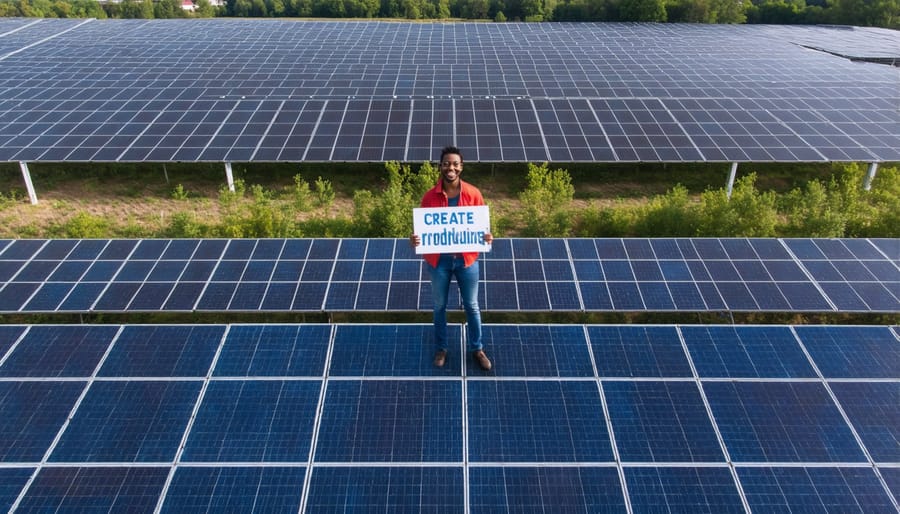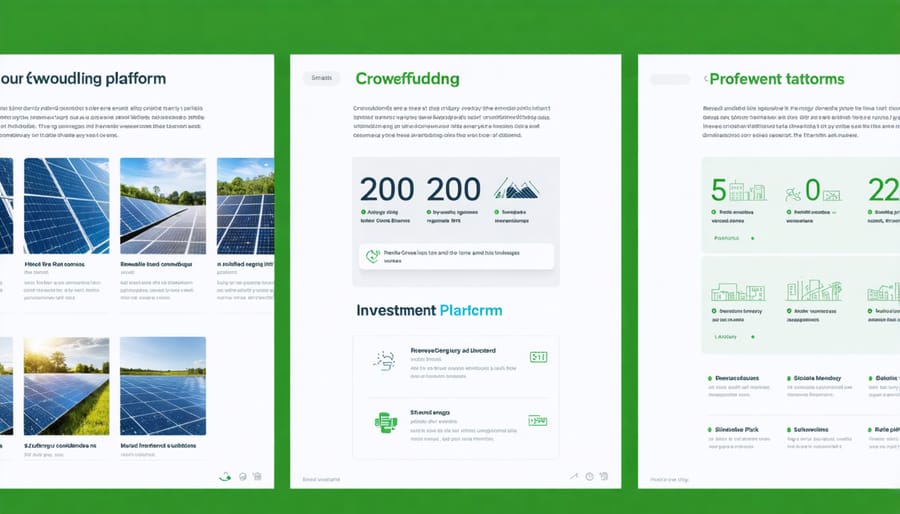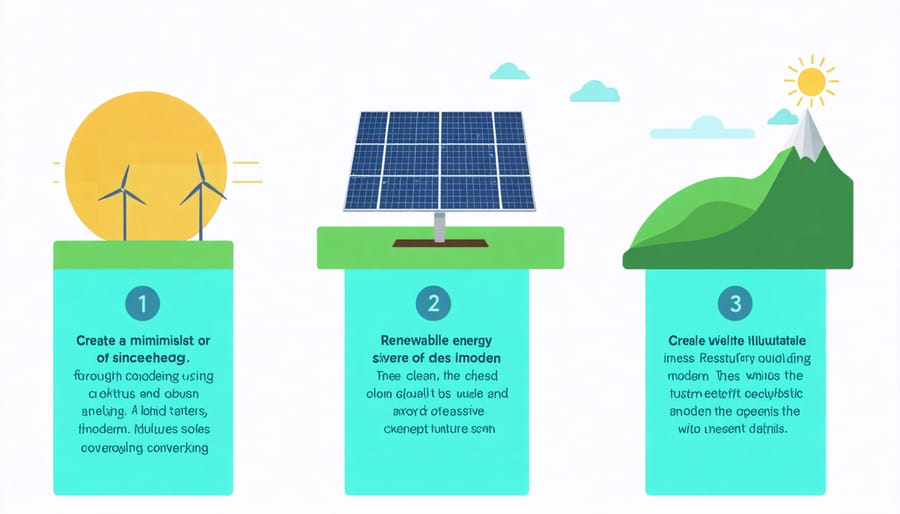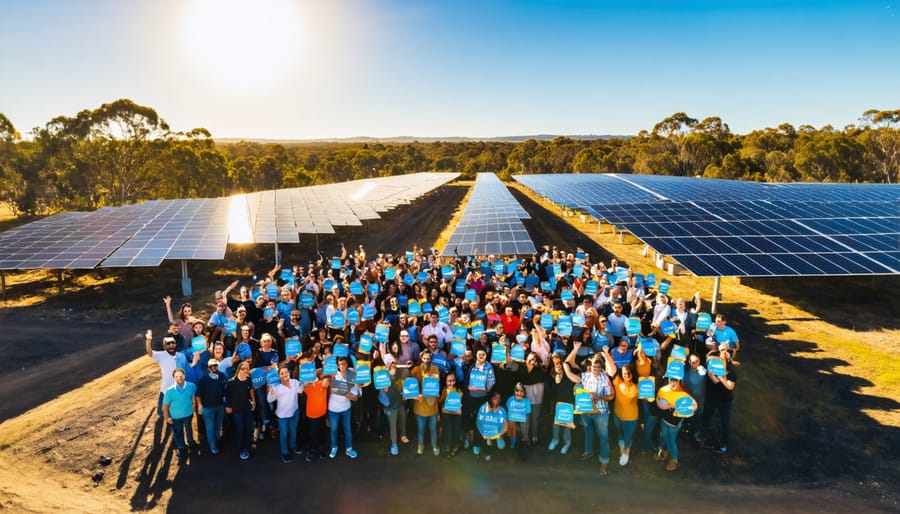Renewable energy crowdfunding is revolutionizing how everyday Australians can directly participate in and profit from the clean energy transition. Through platforms like Clean Energy Crowd and Renewable Crowd Australia, individuals can invest as little as $50 in solar farms, wind projects, and bioenergy facilities across the country, earning potential returns while accelerating sustainable development.
This democratic approach to energy financing has already mobilized over $100 million for Australian renewable projects since 2019, with the average investment yielding 5-7% annual returns. Community-funded solar installations in regional towns like Bendigo and Ballarat demonstrate how collective action can transform local energy systems while building community wealth.
For environmentally conscious investors, crowdfunding opens a direct path to support Australia’s renewable energy targets while diversifying their portfolios. Unlike traditional energy investments, these platforms offer transparency about project impacts, from carbon emissions avoided to jobs created. As Australia races to achieve 50% renewable energy by 2030, crowdfunding is emerging as a crucial tool for accelerating the transition while ensuring its benefits are shared across society.
Learn how you can join this renewable energy revolution, whether you’re an individual investor seeking sustainable returns or a project developer looking to tap into community capital.
Why Crowdfunding is Revolutionising Renewable Energy Projects
Breaking Down Financial Barriers
Crowdfunding platforms are revolutionizing how everyday Australians can participate in the renewable energy revolution, breaking down traditional investment barriers that once restricted participation to large institutional investors. Through these innovative platforms, individuals can invest in solar, wind, and bioenergy projects with as little as $50, democratizing access to sustainable energy investments.
Popular Australian platforms like Bricklet and DomaCom have created user-friendly interfaces that simplify the investment process, making it as straightforward as online shopping. These platforms provide detailed project information, expected returns, and risk assessments in clear, accessible language, helping investors make informed decisions regardless of their financial expertise.
The social aspect of crowdfunding adds another compelling dimension, as investors can track their impact in real-time and connect with like-minded individuals. Many platforms offer regular updates on project milestones, energy generation statistics, and community benefits, creating a sense of involvement beyond the financial investment.
For first-time investors, these platforms typically provide educational resources and support services, ensuring everyone can participate in Australia’s renewable energy transition, regardless of their investment experience or financial capacity.
Community Power in Action
Across Australia, community-powered green energy projects are demonstrating the remarkable potential of crowdfunding in renewable energy. The Hepburn Wind Farm in Victoria stands as a shining example, where over 2,000 local investors raised $9.8 million to establish Australia’s first community-owned wind farm, now powering more than 2,000 homes.
In Byron Bay, the COREM (Community Owned Renewable Energy Mullumbimby) initiative successfully funded multiple solar installations on community buildings through local investments ranging from $250 to $10,000. The project not only generates clean energy but returns dividends to investors while supporting local community services.
The Lismore Community Solar initiative took an innovative approach by installing two 100kW solar farms using a unique funding model where community members invest through a council-operated revolving fund. This project has become a blueprint for other councils nationwide, showing how local governments and communities can work together to create sustainable energy solutions.
These success stories demonstrate how everyday Australians are taking control of their energy future while building stronger, more resilient communities.

Top Australian Renewable Energy Crowdfunding Platforms
Solar Share Platforms
Solar-specific crowdfunding platforms have emerged as game-changers in Australia’s renewable energy landscape, making it easier than ever for small investors in clean energy to participate in the solar revolution. These platforms connect everyday Australians with promising solar projects, from community solar farms to rooftop installations on schools and businesses.
Leading platforms like Solar Share and Sun Exchange have revolutionised how Australians can invest in solar projects, with minimum investments starting from as little as $50. These platforms typically operate on a revenue-sharing model, where investors receive returns based on the energy generated and sold to the grid or end-users.
The rise of blockchain-powered solar investments has added another dimension to solar crowdfunding, offering unprecedented transparency and automated payment systems. Investors can track their solar assets’ performance in real-time and receive automatic distributions of their earnings.
Success stories abound, like the Bendigo Community Solar Farm, which raised $300,000 from local investors through a dedicated solar platform. The project now powers hundreds of homes while providing steady returns to its community investors.
Most platforms offer detailed project assessments, including expected returns, technical specifications, and environmental impact metrics. They also handle all legal documentation and ongoing management, making it straightforward for investors to build their solar portfolio while contributing to Australia’s clean energy future.
Bioenergy Investment Opportunities
Bioenergy investment opportunities in Australia are gaining momentum through innovative crowdfunding platforms that connect investors with promising biomass and waste-to-energy projects. Leading platforms like Birchal and VentureCrowd have successfully facilitated funding for several bioenergy initiatives, including regional biogas facilities and agricultural waste conversion projects.
A standout example is the Biomass Success project in regional Victoria, which raised over $2 million through community-based crowdfunding. This facility now converts agricultural waste into clean energy, powering local farms and businesses while providing investors with steady returns.
Crowdfunding platforms specifically catering to bioenergy projects typically offer investment options starting from as little as $250, making it accessible for everyday Australians to participate in the renewable energy transition. These investments often come with clear environmental impact metrics, helping investors track their contribution to reducing carbon emissions.
Popular investment categories include:
– Agricultural waste-to-energy conversion facilities
– Municipal organic waste processing plants
– Forestry residue utilisation projects
– Food waste biogas generation
– Industrial biomass cogeneration systems
For those new to bioenergy investing, many platforms provide educational resources and detailed project assessments. They often partner with established energy companies and environmental consultants to ensure project viability and risk management.
The growing success of bioenergy crowdfunding in Australia demonstrates the public’s appetite for sustainable investment opportunities. Projects like the Central Queensland Biogas Initiative have shown that community-funded bioenergy facilities can deliver both environmental benefits and attractive financial returns, with some projects reporting annual returns between 7-12%.
Before investing, it’s recommended to thoroughly review project documentation, understand the risks involved, and consider how bioenergy investments align with your overall investment strategy and environmental goals.
Success Stories: From Small Change to Big Impact

Community Solar Farms
Community solar farms represent one of the most successful applications of renewable energy crowdfunding in Australia. The Goulburn Community Solar Farm stands as a shining example, where local residents pooled their resources to create a 1.8-megawatt installation powering over 400 homes. The project not only generates clean energy but also provides steady returns to its community investors.
Similar success stories can be found in the Byron Bay Solar Farm, where 350 community members contributed to fund a 5-megawatt installation. The project demonstrates how crowdfunding can bridge the gap between individual action and utility-scale renewable energy development.
These community-owned solar installations typically operate on a subscription model, where participants can buy shares or panels in the project. Returns are generated through electricity sales to the grid or through power purchase agreements with local businesses. The Pingala Community Solar project in Sydney showcases this model effectively, with investors receiving both environmental and financial benefits from their participation.
Regional communities have particularly embraced this approach. The Hepburn Wind Farm, though primarily wind-powered, incorporated solar elements through community funding, proving that mixed renewable energy projects can succeed through collective investment. These initiatives often start with community meetings, feasibility studies, and careful planning to ensure long-term sustainability and community benefit.
Bioenergy Innovation
The bioenergy sector has emerged as an exciting frontier for crowdfunding success in Australia, with several groundbreaking projects leading the way. One standout example is the Ballarat Bioenergy Plant, which raised over $2.5 million through community-driven crowdfunding. The facility now converts local agricultural waste into clean energy, powering approximately 1,500 homes while providing farmers with additional income streams.
In Queensland’s sugar cane region, the Sweet Energy Initiative demonstrates how crowdfunding can transform traditional industries. Local communities pooled resources to fund a bagasse-to-energy conversion facility, turning sugar cane waste into renewable power. The project not only achieved its funding target of $1.8 million but also created a blueprint for similar initiatives across Australia’s agricultural regions.
Small-scale bioenergy projects have found particular success through crowdfunding platforms. The Western Australian Biogas Collective, for instance, united small dairy farmers to fund a shared biodigester facility. With contributions from over 300 community members, the project now processes organic waste from multiple farms, generating both electricity and organic fertilizer.
These success stories highlight how crowdfunding enables communities to take ownership of their energy future while supporting sustainable agriculture. The model has proven particularly effective in regional areas, where traditional funding sources might be limited but community bonds are strong. As platforms evolve and awareness grows, bioenergy crowdfunding continues to demonstrate its potential for driving Australia’s renewable energy transition.

Getting Started: Your Path to Green Energy Investment
Choosing the Right Platform
When selecting a crowdfunding platform for your renewable energy project, several key factors deserve careful consideration. First, look for platforms with a proven track record in clean energy projects and a strong presence in Australia. Established platforms like Clean Energy Crowd and Pozible have successfully funded numerous renewable initiatives across the country.
Consider the platform’s fee structure and payment terms. Most platforms charge a percentage of funds raised, typically ranging from 4% to 8%, plus processing fees. Some platforms operate on an “all-or-nothing” model, where you only receive funds if you reach your target, while others allow flexible funding options.
Security and credibility are paramount. Choose platforms that offer robust verification processes, transparent reporting, and clear communication channels between project creators and investors. Look for platforms that comply with Australian financial regulations and provide necessary documentation for both investors and project creators.
The platform’s reach and community engagement capabilities are also crucial. Platforms with active social media presence and established networks in the renewable energy sector can significantly boost your project’s visibility. Some platforms offer additional support services, such as campaign strategy guidance, marketing tools, and access to industry experts.
Additionally, evaluate the platform’s user interface and technical support. A user-friendly platform with responsive customer service can make the difference between a smooth fundraising experience and a frustrating one. Consider reading reviews from other project creators and checking success rates for similar renewable energy initiatives.
Smart Investment Strategies
When investing in renewable energy crowdfunding projects, it’s essential to adopt a strategic approach to maximize both environmental impact and financial returns. Start by thoroughly researching platforms that specifically focus on impact investment in renewable energy, particularly those with a strong track record in the Australian market.
Consider diversifying your investments across different renewable energy projects to manage risk effectively. Look for projects that have secured partial funding from established institutions or government grants, as these often indicate higher credibility and thorough due diligence.
Pay close attention to the project developer’s experience and track record. Successful renewable energy projects typically have teams with proven expertise in both technical implementation and financial management. Review their past projects and verify their industry partnerships.
Before committing funds, carefully assess the project’s timeline, expected returns, and risk factors. Most successful renewable energy crowdfunding investments offer returns between 5-15% annually, but it’s crucial to understand that longer-term projects may provide more stable returns.
Look for projects with clear milestone reporting and transparent communication channels. The best investments often come with regular updates about project progress and performance metrics. Consider starting with smaller investments across multiple projects to build your portfolio gradually while gaining valuable experience in the sector.
Don’t forget to evaluate the social and environmental impact metrics alongside financial returns. Projects that demonstrate strong community benefits and measurable environmental outcomes often prove more sustainable in the long term.
As Australia moves towards a renewable energy future, crowdfunding stands as a powerful catalyst for transformative change in our energy landscape. The democratization of renewable energy investment through crowdfunding platforms has opened doors for everyday Australians to become active participants in the clean energy revolution, rather than mere observers.
The success stories we’ve explored demonstrate that when communities come together, remarkable achievements are possible. From solar farms in regional Victoria to wind projects in South Australia, crowdfunding has proven its ability to turn ambitious renewable energy goals into reality while delivering both environmental and financial benefits to investors.
Looking ahead, the potential for crowdfunding in Australia’s renewable energy sector appears boundless. As technology advances and platforms become more sophisticated, we can expect to see even more innovative projects emerge. The combination of growing environmental awareness, supportive regulatory frameworks, and the Australian spirit of giving everyone a fair go creates perfect conditions for crowdfunding to flourish.
For individuals and organizations wanting to make a difference, the time to act is now. Whether contributing to existing projects or initiating new ones, crowdfunding offers a tangible way to support Australia’s transition to renewable energy. By embracing this collaborative approach to funding, we’re not just investing in infrastructure – we’re investing in a cleaner, more sustainable future for generations to come.

